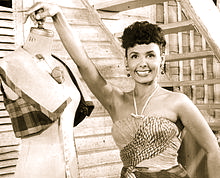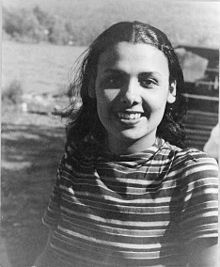Lena Horne


Here’s the full version of a performance that can be found truncated elsewhere on YouTube — from the 1943 film of the same name, the great Lena Horne delivers a sizzling performance of her signature song. (I wish I had the full dance that follows it, which includes some amazing ballet. If anyone has a full-length version, please post it or get in touch with me!) Uploaded by MarkusRTK on Jan 27, 2008.
Horne in her stage show, Nine O’Clock Revue, 1916
Lena Mary Calhoun Horne (born June 30, 1917 – died May 9, 2010) was an American singer, actress, civil rights activist and dancer. Horne joined the chorus of the Cotton Club at the age of sixteen and became a nightclub performer before moving to Hollywood, where she had small parts in numerous movies, and more substantial parts in the films Cabin in the Sky and Stormy Weather. Due to the Red Scare and her left-leaning political views, Horne found herself blacklisted and unable to get work in Hollywood.
Returning to her roots as a nightclub performer, Horne took part in the March on Washington in August 1963, and continued to work as a performer, both in nightclubs and on television, while releasing well-received record albums. She announced her retirement in March 1980, but the next year starred in a one-woman show, Lena Horne: The Lady and Her Music, which ran for more than three hundred performances on Broadway and earned her numerous awards and accolades. She continued recording and performing sporadically into the 1990s, disappearing from the public eye in 2000.
Road to Hollywood
In the fall of 1933, Horne joined the chorus line of the Cotton Club in New York City. In the spring of 1934, she had a featured role in the Cotton Club Parade starring Adelaide Hall who took Lena under her wing. A few years later she joined Noble Sissle‘s Orchestra, with which she toured and with whom she recorded her first record release, a 78rpm single issued by Decca Records. After she separated from her first husband, Horne toured with bandleader Charlie Barnet in 1940–41, but disliked the travel and left the band to work at the Café Societyin New York. She replaced Dinah Shore as the featured vocalist on NBC’s popular jazz series The Chamber Music Society of Lower Basin Street. The show’s resident maestros, Henry Levine and Paul Laval, recorded with Horne in June 1941 for RCA Victor. Horne left the show after only six months to headline a nightclub revue on the West Coast, and was replaced by Linda Keene.
 Lena Horne photographed by Carl Van Vechten, 1941
Lena Horne photographed by Carl Van Vechten, 1941
Horne already had two low-budget movies to her credit: a 1938 musical feature called The Duke is Tops (later reissued with Horne’s name above the title as The Bronze Venus); and a 1941 two-reel short subject, Boogie Woogie Dream, featuring pianists Pete Johnson and Albert Ammons. Horne’s songs from Boogie Woogie Dream were later released individually as soundies. Horne was primarily a nightclub performer during this period, and it was during a 1943 club engagement in Hollywood that talent scouts approached Horne to work in pictures. She chose Metro-Goldwyn-Mayer, and became the first black performer to sign a long-term contract with a major Hollywood studio. November 1944 she was featured in an episode of the popular radio series, Suspense, as a fictional nightclub singer, with a large speaking role along with her singing. In 1945 and 1946 she sang with Billy Eckstine‘s Orchestra.
She made her debut with MGM in Panama Hattie (1942) and performed the title song of Stormy Weather based loosely on the life of Adelaide Hall, (1943), which she made at 20th Century Fox, on loan from MGM. She appeared in a number of MGM musicals, most notably Cabin in the Sky (also 1943), but was never featured in a leading role because of her race and the fact that films featuring her had to be re-edited for showing in states where theaters could not show films with black performers. As a result, most of Horne’s film appearances were stand-alone sequences that had no bearing on the rest of the film, so editing caused no disruption to the storyline; a notable exception was the all-black musical Cabin in the Sky, although one number was cut because it was considered too suggestive by the censors. “Ain’t it the Truth” was the song (and scene) cut before the release of the film Cabin in the Sky. It featured Horne singing “Ain’t it the Truth”, while taking a bubble bath (considered too “risqué” by the film’s executives). This scene and song are featured in the film That’s Entertainment! III (1994) which also featured commentary from Horne on why the scene was deleted prior to the film’s release. She enjoyed the times but Horne was always confused on the arts,but that’s her. Magazines said well that’s Horne for you.
In Ziegfeld Follies (1946) she performed “Love” by Hugh Martin and Ralph Blane. Horne wanted to be considered for the role of Julie LaVerne in MGM’s 1951 version of Show Boat (having already played the role when a segment of Show Boat was performed in Till the Clouds Roll By) but lost the part to Ava Gardner, a personal friend in real life, due to the Production Code‘s ban on interracial relationships in films. In the documentary That’s Entertainment! III Horne stated that MGM executives required Gardner to practice her singing using Horne’s recordings, which offended both actresses. Ultimately, Gardner’s voice was overdubbed by actress Annette Warren (Smith) for the theatrical release.


